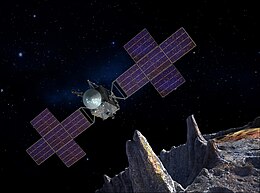
Back مركبة سايكي الفضائية Arabic Psyche (svemirska letjelica) BS Psyche (nau espacial) Catalan Psyche (rumfartøj) Danish Psyche (Raumsonde) German Psyche (nave espacial) Spanish Psyche Estonian سایکی (فضاپیما) Persian Psyché (sonde spatiale) French Psyche (nave espacial) Galician
 An artist's concept illustration of the Psyche spacecraft as it orbits 16 Psyche | |||||||||||
| Mission type | Asteroid orbiter | ||||||||||
|---|---|---|---|---|---|---|---|---|---|---|---|
| Operator | |||||||||||
| COSPAR ID | 2023-157A | ||||||||||
| SATCAT no. | 58049 | ||||||||||
| Website |
| ||||||||||
| Mission duration | Cruise: 1 year, 3 months, 13 days (in progress)[1] Science: 21 months in orbit | ||||||||||
| Spacecraft properties | |||||||||||
| Spacecraft | Psyche | ||||||||||
| Manufacturer | Maxar Technologies[2] | ||||||||||
| Launch mass | 2,608 kg (5,750 lb)[3] | ||||||||||
| Dry mass | 1,648 kg (3,633 lb)[4] | ||||||||||
| Payload mass | 30 kg (66 lb) | ||||||||||
| Power | 4.5 kW | ||||||||||
| Start of mission | |||||||||||
| Launch date | 2023 October 13, 14:19 UTC[5][6] | ||||||||||
| Rocket | Falcon Heavy[7] | ||||||||||
| Launch site | Kennedy Space Center, LC-39A | ||||||||||
| Contractor | SpaceX | ||||||||||
| 16 Psyche orbiter | |||||||||||
| Orbital insertion | August 2029[1] | ||||||||||
| |||||||||||
 Psyche mission patch | |||||||||||
Psyche (/ˈsaɪki/ SY-kee) is a NASA Discovery Program space mission launched on October 13, 2023, to explore the origin of planetary cores by orbiting and studying the metallic asteroid 16 Psyche beginning in 2029.[8] NASA's Jet Propulsion Laboratory (JPL) manages the project.
The spacecraft will not land on the asteroid, but will orbit it from August 5, 2029, to October 31, 2031, spending 817 days in orbit. Psyche uses solar-powered Hall-effect thrusters for propulsion and orbital maneuvering, the first interplanetary spacecraft to use that technology. It's also the first mission to use laser optical communications beyond the Earth-Moon system.
Asteroid 16 Psyche is the heaviest known M-type asteroid, and may be an exposed iron core of a protoplanet, the remnant of a violent collision with another object that stripped off its mantle and crust. On January 4, 2017, the Psyche mission was selected for NASA's Discovery #14 mission.[9] It was launched atop a SpaceX Falcon Heavy rocket.[10]
- ^ a b "NASA Continues Psyche Asteroid Mission". JPL. NASA. October 28, 2022. Archived from the original on November 8, 2022. Retrieved October 28, 2022.
- ^ a b "FY 2021 President's Budget Request Summary" (PDF). NASA. February 10, 2020. pp. 437–439. Archived (PDF) from the original on June 17, 2020. Retrieved February 22, 2020.
 This article incorporates text from this source, which is in the public domain.
This article incorporates text from this source, which is in the public domain.
- ^ Cite error: The named reference
Gerrit 2015was invoked but never defined (see the help page). - ^ "Psyche: Journey to a Metallic World". Archived from the original on February 11, 2021. Retrieved February 9, 2021 – via www.youtube.com.
- ^ Strickland, Ashley (October 13, 2023). "NASA launches a spacecraft to visit Psyche, an unseen metal world". CNN. Archived from the original on October 13, 2023. Retrieved October 13, 2023.
- ^ Clark, Stephen (October 13, 2023). "NASA just launched the Psyche mission—no one knows what it will find". Ars Technica. Archived from the original on October 13, 2023. Retrieved October 13, 2023.
- ^ Foust, Jeff (February 28, 2020). "Falcon Heavy to launch NASA Psyche asteroid mission". SpaceNews. Archived from the original on March 1, 2020. Retrieved February 29, 2020.
- ^ Chang, Kenneth (January 6, 2017). "A Metal Ball the Size of Massachusetts That NASA Wants to Explore". The New York Times. Archived from the original on January 7, 2017. Retrieved March 3, 2017.
- ^ Grush, Loren (January 4, 2017). "In the 2020s NASA will launch spacecraft to study Jupiter's asteroids, and another made of metal". The Verge. Archived from the original on January 5, 2017. Retrieved September 8, 2017.
- ^ Dinner, Josh (October 13, 2023). "SpaceX Falcon Heavy rocket launches NASA's Psyche probe to bizarre metal asteroid (video)". Space.com. Archived from the original on October 18, 2023. Retrieved October 18, 2023.